Taxation Law - Receipts and Proceeds: Sophie, Kate, and Joe
VerifiedAdded on 2022/11/30
|13
|3733
|127
Homework Assignment
AI Summary
This assignment analyzes the taxation implications of various financial transactions for Sophie, Kate, and Joe, focusing on the assessability of different receipts and proceeds under Australian taxation law. The assignment examines scenarios involving a faulty laser machine, personal injury, compensation for reputational damage, loss of earnings, medical expenses, and legal fees. It delves into the application of capital gains tax (CGT) and ordinary income principles, referencing relevant legal precedents such as Whitaker v FC of T, FC of T v Sydney Refractive Surgery Centre Pty Ltd, and Allied Mills Industries Pty Ltd v Commissioner of Taxation. The solution provides detailed analysis of each transaction, determining whether the receipts are considered CGT gains, ordinary income, or deductible expenses, and how reimbursements affect tax offsets. The conclusion summarizes the tax treatment of each receipt for Sophie, Kate, and Joe, offering a comprehensive understanding of taxation law principles in the context of the given scenarios.
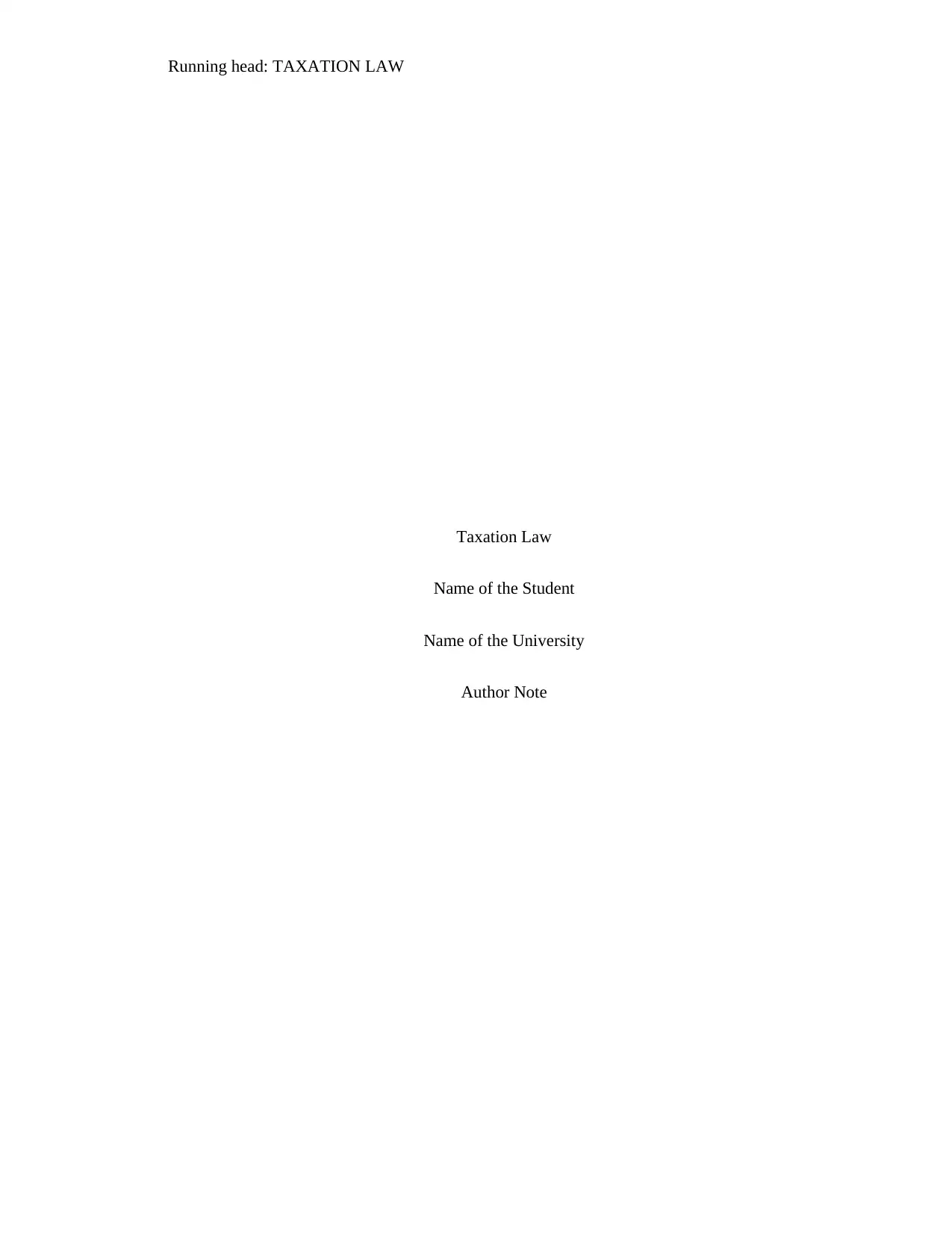
Running head: TAXATION LAW
Taxation Law
Name of the Student
Name of the University
Author Note
Taxation Law
Name of the Student
Name of the University
Author Note
Paraphrase This Document
Need a fresh take? Get an instant paraphrase of this document with our AI Paraphraser
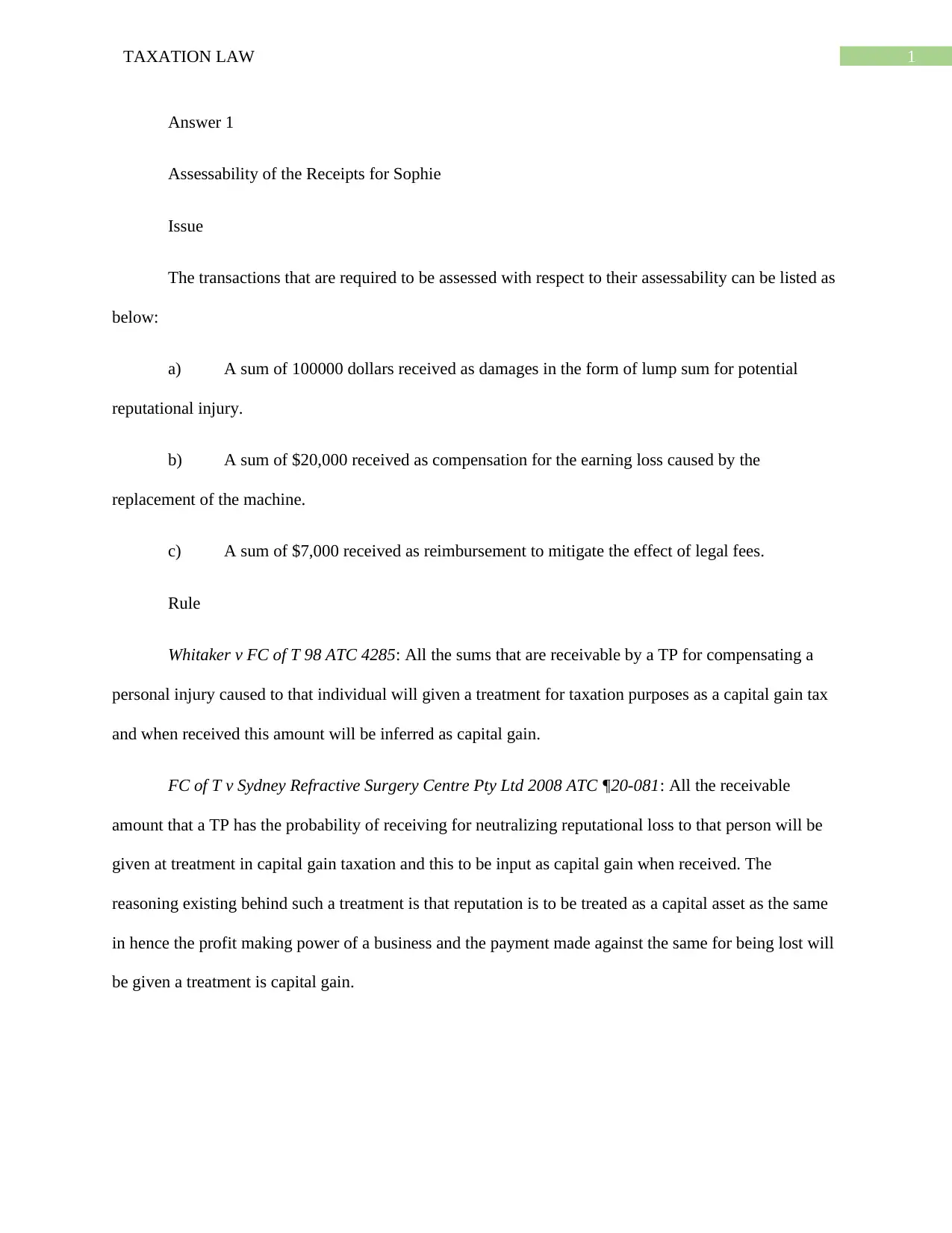
1TAXATION LAW
Answer 1
Assessability of the Receipts for Sophie
Issue
The transactions that are required to be assessed with respect to their assessability can be listed as
below:
a) A sum of 100000 dollars received as damages in the form of lump sum for potential
reputational injury.
b) A sum of $20,000 received as compensation for the earning loss caused by the
replacement of the machine.
c) A sum of $7,000 received as reimbursement to mitigate the effect of legal fees.
Rule
Whitaker v FC of T 98 ATC 4285: All the sums that are receivable by a TP for compensating a
personal injury caused to that individual will given a treatment for taxation purposes as a capital gain tax
and when received this amount will be inferred as capital gain.
FC of T v Sydney Refractive Surgery Centre Pty Ltd 2008 ATC ¶20-081: All the receivable
amount that a TP has the probability of receiving for neutralizing reputational loss to that person will be
given at treatment in capital gain taxation and this to be input as capital gain when received. The
reasoning existing behind such a treatment is that reputation is to be treated as a capital asset as the same
in hence the profit making power of a business and the payment made against the same for being lost will
be given a treatment is capital gain.
Answer 1
Assessability of the Receipts for Sophie
Issue
The transactions that are required to be assessed with respect to their assessability can be listed as
below:
a) A sum of 100000 dollars received as damages in the form of lump sum for potential
reputational injury.
b) A sum of $20,000 received as compensation for the earning loss caused by the
replacement of the machine.
c) A sum of $7,000 received as reimbursement to mitigate the effect of legal fees.
Rule
Whitaker v FC of T 98 ATC 4285: All the sums that are receivable by a TP for compensating a
personal injury caused to that individual will given a treatment for taxation purposes as a capital gain tax
and when received this amount will be inferred as capital gain.
FC of T v Sydney Refractive Surgery Centre Pty Ltd 2008 ATC ¶20-081: All the receivable
amount that a TP has the probability of receiving for neutralizing reputational loss to that person will be
given at treatment in capital gain taxation and this to be input as capital gain when received. The
reasoning existing behind such a treatment is that reputation is to be treated as a capital asset as the same
in hence the profit making power of a business and the payment made against the same for being lost will
be given a treatment is capital gain.
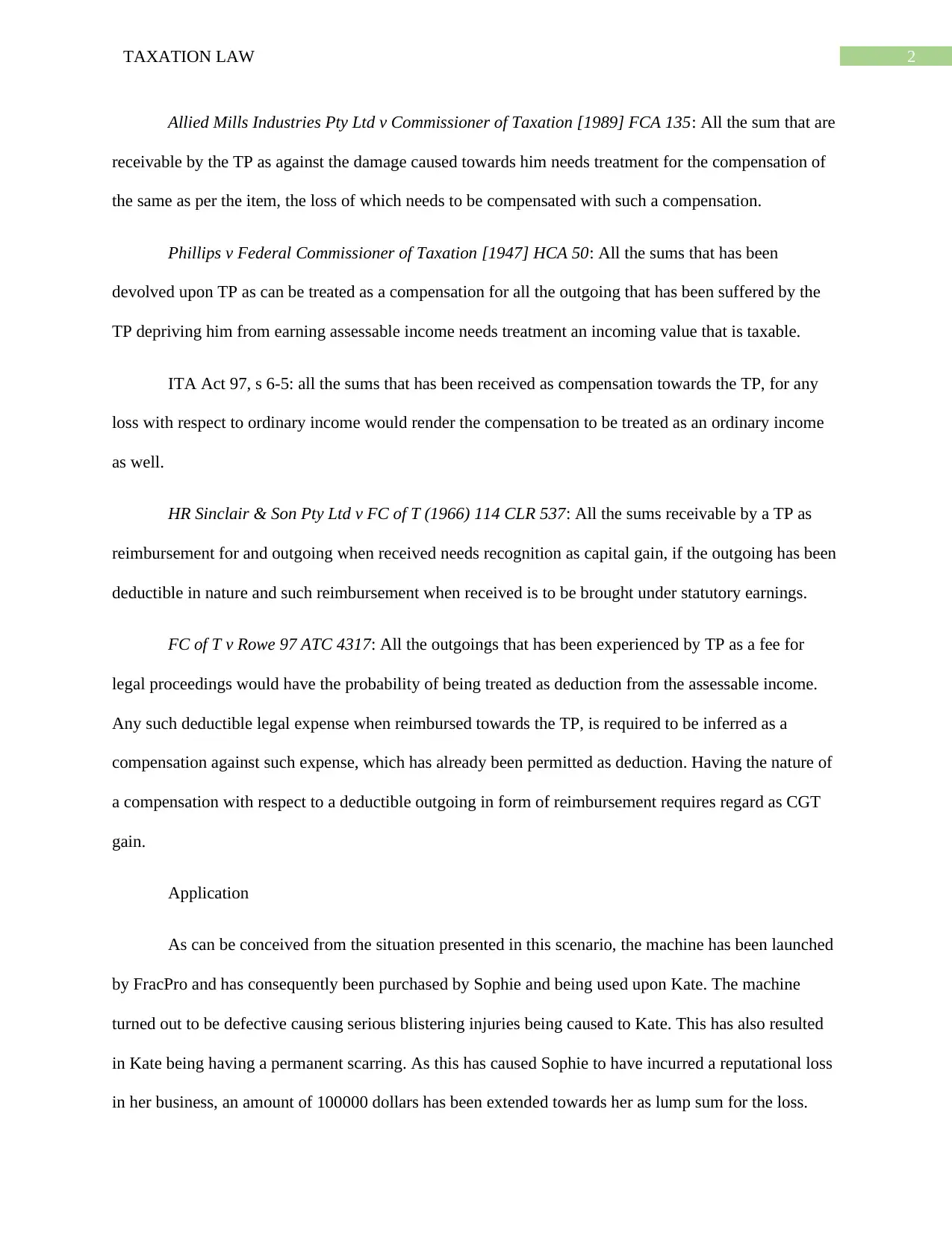
2TAXATION LAW
Allied Mills Industries Pty Ltd v Commissioner of Taxation [1989] FCA 135: All the sum that are
receivable by the TP as against the damage caused towards him needs treatment for the compensation of
the same as per the item, the loss of which needs to be compensated with such a compensation.
Phillips v Federal Commissioner of Taxation [1947] HCA 50: All the sums that has been
devolved upon TP as can be treated as a compensation for all the outgoing that has been suffered by the
TP depriving him from earning assessable income needs treatment an incoming value that is taxable.
ITA Act 97, s 6-5: all the sums that has been received as compensation towards the TP, for any
loss with respect to ordinary income would render the compensation to be treated as an ordinary income
as well.
HR Sinclair & Son Pty Ltd v FC of T (1966) 114 CLR 537: All the sums receivable by a TP as
reimbursement for and outgoing when received needs recognition as capital gain, if the outgoing has been
deductible in nature and such reimbursement when received is to be brought under statutory earnings.
FC of T v Rowe 97 ATC 4317: All the outgoings that has been experienced by TP as a fee for
legal proceedings would have the probability of being treated as deduction from the assessable income.
Any such deductible legal expense when reimbursed towards the TP, is required to be inferred as a
compensation against such expense, which has already been permitted as deduction. Having the nature of
a compensation with respect to a deductible outgoing in form of reimbursement requires regard as CGT
gain.
Application
As can be conceived from the situation presented in this scenario, the machine has been launched
by FracPro and has consequently been purchased by Sophie and being used upon Kate. The machine
turned out to be defective causing serious blistering injuries being caused to Kate. This has also resulted
in Kate being having a permanent scarring. As this has caused Sophie to have incurred a reputational loss
in her business, an amount of 100000 dollars has been extended towards her as lump sum for the loss.
Allied Mills Industries Pty Ltd v Commissioner of Taxation [1989] FCA 135: All the sum that are
receivable by the TP as against the damage caused towards him needs treatment for the compensation of
the same as per the item, the loss of which needs to be compensated with such a compensation.
Phillips v Federal Commissioner of Taxation [1947] HCA 50: All the sums that has been
devolved upon TP as can be treated as a compensation for all the outgoing that has been suffered by the
TP depriving him from earning assessable income needs treatment an incoming value that is taxable.
ITA Act 97, s 6-5: all the sums that has been received as compensation towards the TP, for any
loss with respect to ordinary income would render the compensation to be treated as an ordinary income
as well.
HR Sinclair & Son Pty Ltd v FC of T (1966) 114 CLR 537: All the sums receivable by a TP as
reimbursement for and outgoing when received needs recognition as capital gain, if the outgoing has been
deductible in nature and such reimbursement when received is to be brought under statutory earnings.
FC of T v Rowe 97 ATC 4317: All the outgoings that has been experienced by TP as a fee for
legal proceedings would have the probability of being treated as deduction from the assessable income.
Any such deductible legal expense when reimbursed towards the TP, is required to be inferred as a
compensation against such expense, which has already been permitted as deduction. Having the nature of
a compensation with respect to a deductible outgoing in form of reimbursement requires regard as CGT
gain.
Application
As can be conceived from the situation presented in this scenario, the machine has been launched
by FracPro and has consequently been purchased by Sophie and being used upon Kate. The machine
turned out to be defective causing serious blistering injuries being caused to Kate. This has also resulted
in Kate being having a permanent scarring. As this has caused Sophie to have incurred a reputational loss
in her business, an amount of 100000 dollars has been extended towards her as lump sum for the loss.
⊘ This is a preview!⊘
Do you want full access?
Subscribe today to unlock all pages.

Trusted by 1+ million students worldwide
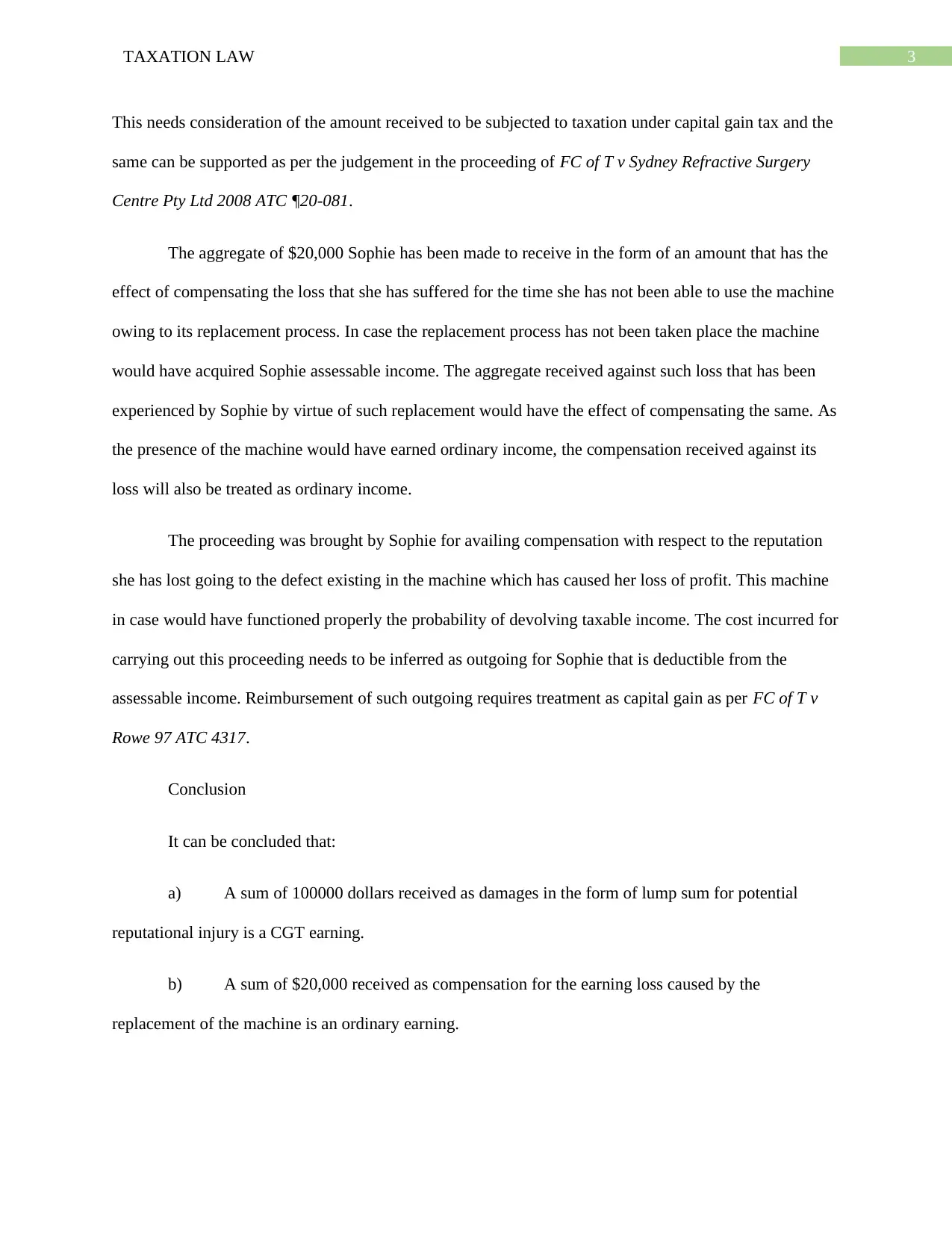
3TAXATION LAW
This needs consideration of the amount received to be subjected to taxation under capital gain tax and the
same can be supported as per the judgement in the proceeding of FC of T v Sydney Refractive Surgery
Centre Pty Ltd 2008 ATC ¶20-081.
The aggregate of $20,000 Sophie has been made to receive in the form of an amount that has the
effect of compensating the loss that she has suffered for the time she has not been able to use the machine
owing to its replacement process. In case the replacement process has not been taken place the machine
would have acquired Sophie assessable income. The aggregate received against such loss that has been
experienced by Sophie by virtue of such replacement would have the effect of compensating the same. As
the presence of the machine would have earned ordinary income, the compensation received against its
loss will also be treated as ordinary income.
The proceeding was brought by Sophie for availing compensation with respect to the reputation
she has lost going to the defect existing in the machine which has caused her loss of profit. This machine
in case would have functioned properly the probability of devolving taxable income. The cost incurred for
carrying out this proceeding needs to be inferred as outgoing for Sophie that is deductible from the
assessable income. Reimbursement of such outgoing requires treatment as capital gain as per FC of T v
Rowe 97 ATC 4317.
Conclusion
It can be concluded that:
a) A sum of 100000 dollars received as damages in the form of lump sum for potential
reputational injury is a CGT earning.
b) A sum of $20,000 received as compensation for the earning loss caused by the
replacement of the machine is an ordinary earning.
This needs consideration of the amount received to be subjected to taxation under capital gain tax and the
same can be supported as per the judgement in the proceeding of FC of T v Sydney Refractive Surgery
Centre Pty Ltd 2008 ATC ¶20-081.
The aggregate of $20,000 Sophie has been made to receive in the form of an amount that has the
effect of compensating the loss that she has suffered for the time she has not been able to use the machine
owing to its replacement process. In case the replacement process has not been taken place the machine
would have acquired Sophie assessable income. The aggregate received against such loss that has been
experienced by Sophie by virtue of such replacement would have the effect of compensating the same. As
the presence of the machine would have earned ordinary income, the compensation received against its
loss will also be treated as ordinary income.
The proceeding was brought by Sophie for availing compensation with respect to the reputation
she has lost going to the defect existing in the machine which has caused her loss of profit. This machine
in case would have functioned properly the probability of devolving taxable income. The cost incurred for
carrying out this proceeding needs to be inferred as outgoing for Sophie that is deductible from the
assessable income. Reimbursement of such outgoing requires treatment as capital gain as per FC of T v
Rowe 97 ATC 4317.
Conclusion
It can be concluded that:
a) A sum of 100000 dollars received as damages in the form of lump sum for potential
reputational injury is a CGT earning.
b) A sum of $20,000 received as compensation for the earning loss caused by the
replacement of the machine is an ordinary earning.
Paraphrase This Document
Need a fresh take? Get an instant paraphrase of this document with our AI Paraphraser
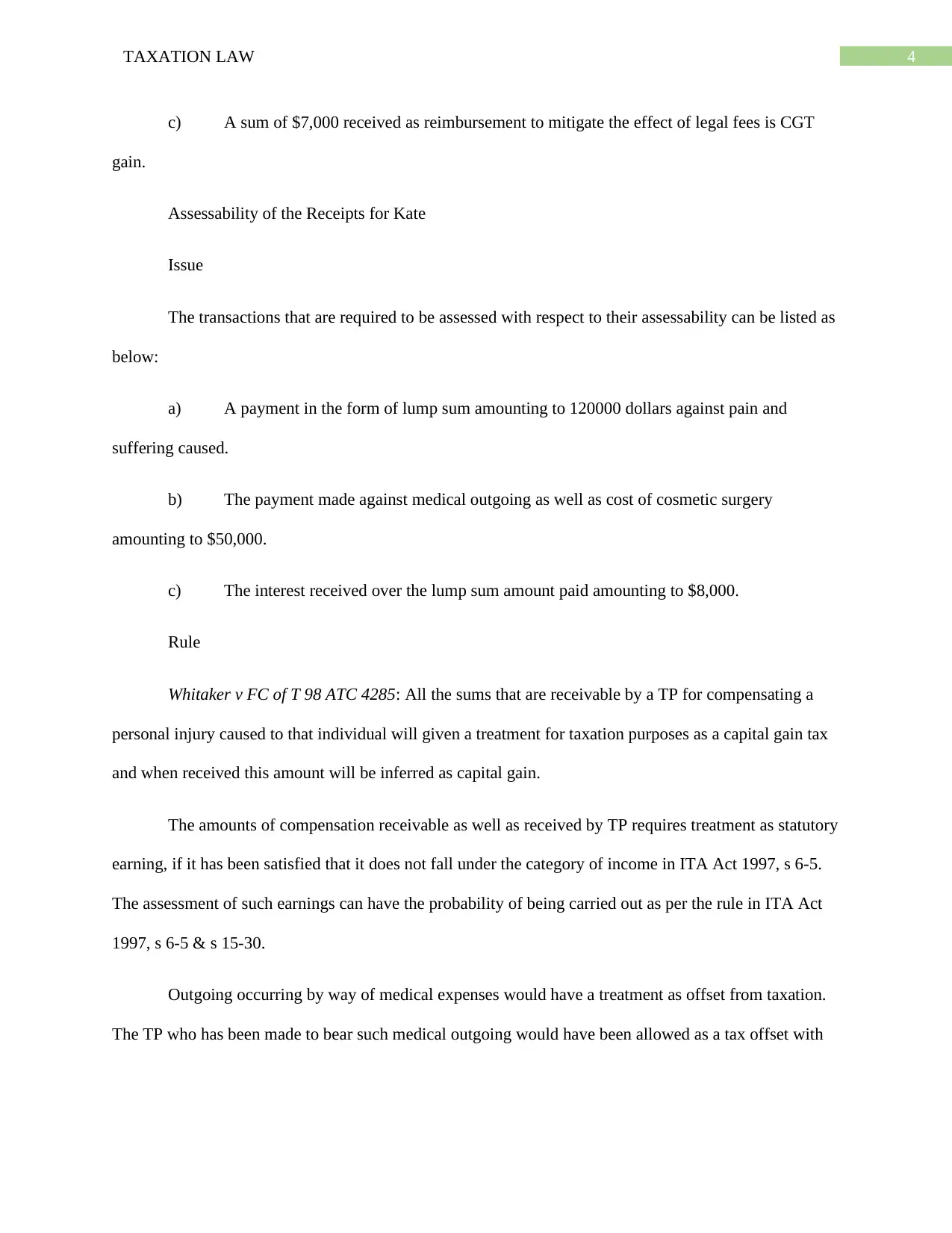
4TAXATION LAW
c) A sum of $7,000 received as reimbursement to mitigate the effect of legal fees is CGT
gain.
Assessability of the Receipts for Kate
Issue
The transactions that are required to be assessed with respect to their assessability can be listed as
below:
a) A payment in the form of lump sum amounting to 120000 dollars against pain and
suffering caused.
b) The payment made against medical outgoing as well as cost of cosmetic surgery
amounting to $50,000.
c) The interest received over the lump sum amount paid amounting to $8,000.
Rule
Whitaker v FC of T 98 ATC 4285: All the sums that are receivable by a TP for compensating a
personal injury caused to that individual will given a treatment for taxation purposes as a capital gain tax
and when received this amount will be inferred as capital gain.
The amounts of compensation receivable as well as received by TP requires treatment as statutory
earning, if it has been satisfied that it does not fall under the category of income in ITA Act 1997, s 6-5.
The assessment of such earnings can have the probability of being carried out as per the rule in ITA Act
1997, s 6-5 & s 15-30.
Outgoing occurring by way of medical expenses would have a treatment as offset from taxation.
The TP who has been made to bear such medical outgoing would have been allowed as a tax offset with
c) A sum of $7,000 received as reimbursement to mitigate the effect of legal fees is CGT
gain.
Assessability of the Receipts for Kate
Issue
The transactions that are required to be assessed with respect to their assessability can be listed as
below:
a) A payment in the form of lump sum amounting to 120000 dollars against pain and
suffering caused.
b) The payment made against medical outgoing as well as cost of cosmetic surgery
amounting to $50,000.
c) The interest received over the lump sum amount paid amounting to $8,000.
Rule
Whitaker v FC of T 98 ATC 4285: All the sums that are receivable by a TP for compensating a
personal injury caused to that individual will given a treatment for taxation purposes as a capital gain tax
and when received this amount will be inferred as capital gain.
The amounts of compensation receivable as well as received by TP requires treatment as statutory
earning, if it has been satisfied that it does not fall under the category of income in ITA Act 1997, s 6-5.
The assessment of such earnings can have the probability of being carried out as per the rule in ITA Act
1997, s 6-5 & s 15-30.
Outgoing occurring by way of medical expenses would have a treatment as offset from taxation.
The TP who has been made to bear such medical outgoing would have been allowed as a tax offset with
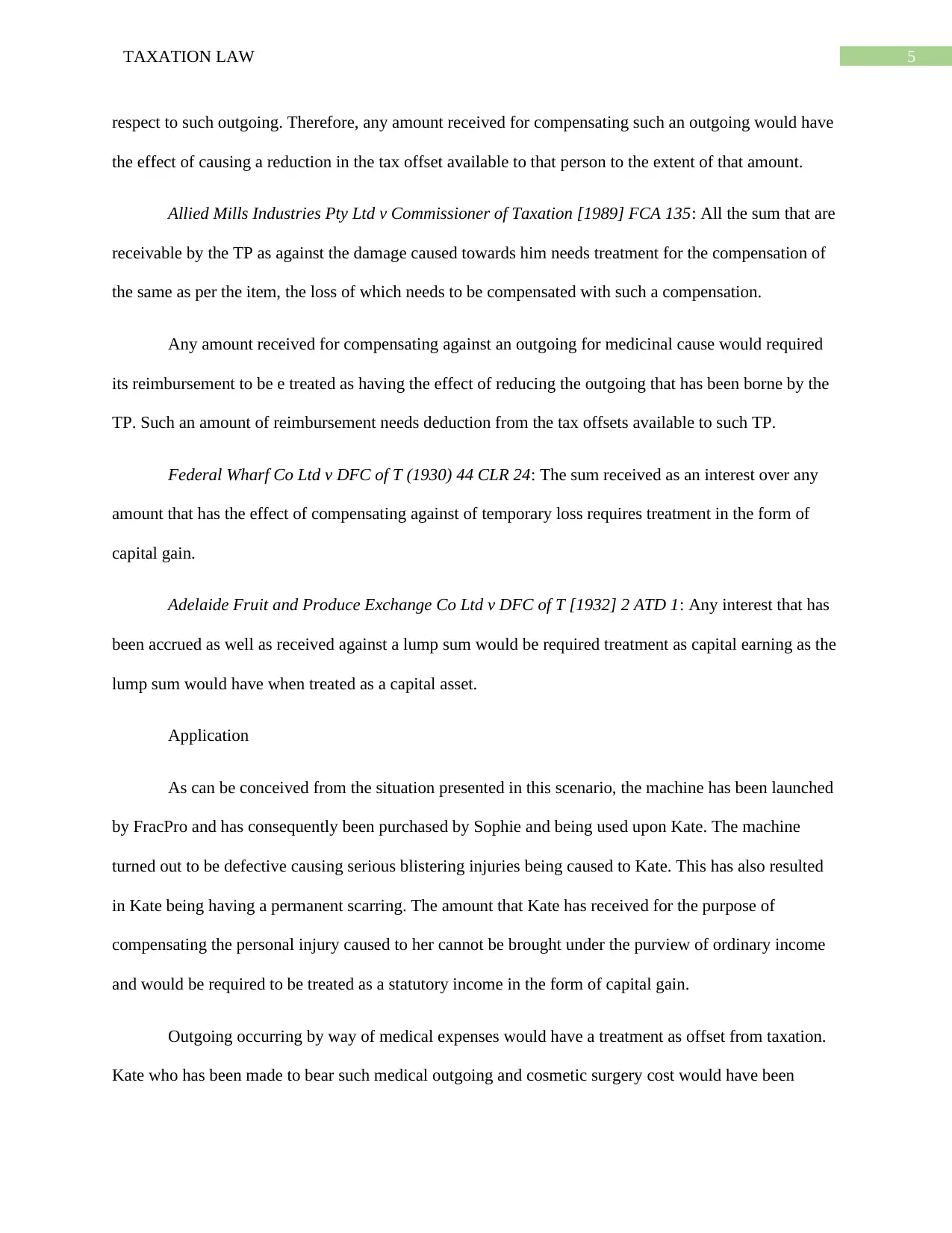
5TAXATION LAW
respect to such outgoing. Therefore, any amount received for compensating such an outgoing would have
the effect of causing a reduction in the tax offset available to that person to the extent of that amount.
Allied Mills Industries Pty Ltd v Commissioner of Taxation [1989] FCA 135: All the sum that are
receivable by the TP as against the damage caused towards him needs treatment for the compensation of
the same as per the item, the loss of which needs to be compensated with such a compensation.
Any amount received for compensating against an outgoing for medicinal cause would required
its reimbursement to be e treated as having the effect of reducing the outgoing that has been borne by the
TP. Such an amount of reimbursement needs deduction from the tax offsets available to such TP.
Federal Wharf Co Ltd v DFC of T (1930) 44 CLR 24: The sum received as an interest over any
amount that has the effect of compensating against of temporary loss requires treatment in the form of
capital gain.
Adelaide Fruit and Produce Exchange Co Ltd v DFC of T [1932] 2 ATD 1: Any interest that has
been accrued as well as received against a lump sum would be required treatment as capital earning as the
lump sum would have when treated as a capital asset.
Application
As can be conceived from the situation presented in this scenario, the machine has been launched
by FracPro and has consequently been purchased by Sophie and being used upon Kate. The machine
turned out to be defective causing serious blistering injuries being caused to Kate. This has also resulted
in Kate being having a permanent scarring. The amount that Kate has received for the purpose of
compensating the personal injury caused to her cannot be brought under the purview of ordinary income
and would be required to be treated as a statutory income in the form of capital gain.
Outgoing occurring by way of medical expenses would have a treatment as offset from taxation.
Kate who has been made to bear such medical outgoing and cosmetic surgery cost would have been
respect to such outgoing. Therefore, any amount received for compensating such an outgoing would have
the effect of causing a reduction in the tax offset available to that person to the extent of that amount.
Allied Mills Industries Pty Ltd v Commissioner of Taxation [1989] FCA 135: All the sum that are
receivable by the TP as against the damage caused towards him needs treatment for the compensation of
the same as per the item, the loss of which needs to be compensated with such a compensation.
Any amount received for compensating against an outgoing for medicinal cause would required
its reimbursement to be e treated as having the effect of reducing the outgoing that has been borne by the
TP. Such an amount of reimbursement needs deduction from the tax offsets available to such TP.
Federal Wharf Co Ltd v DFC of T (1930) 44 CLR 24: The sum received as an interest over any
amount that has the effect of compensating against of temporary loss requires treatment in the form of
capital gain.
Adelaide Fruit and Produce Exchange Co Ltd v DFC of T [1932] 2 ATD 1: Any interest that has
been accrued as well as received against a lump sum would be required treatment as capital earning as the
lump sum would have when treated as a capital asset.
Application
As can be conceived from the situation presented in this scenario, the machine has been launched
by FracPro and has consequently been purchased by Sophie and being used upon Kate. The machine
turned out to be defective causing serious blistering injuries being caused to Kate. This has also resulted
in Kate being having a permanent scarring. The amount that Kate has received for the purpose of
compensating the personal injury caused to her cannot be brought under the purview of ordinary income
and would be required to be treated as a statutory income in the form of capital gain.
Outgoing occurring by way of medical expenses would have a treatment as offset from taxation.
Kate who has been made to bear such medical outgoing and cosmetic surgery cost would have been
⊘ This is a preview!⊘
Do you want full access?
Subscribe today to unlock all pages.

Trusted by 1+ million students worldwide
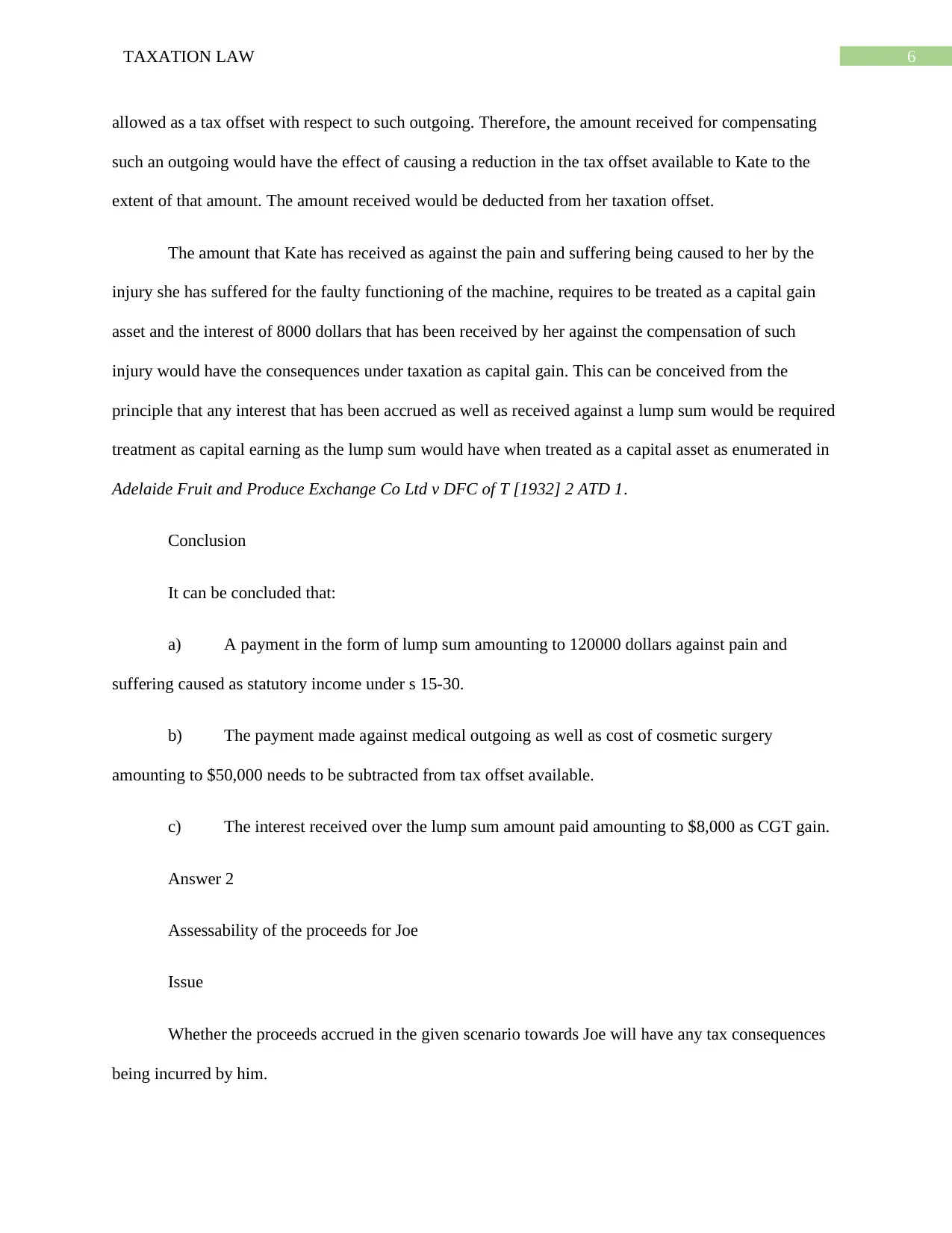
6TAXATION LAW
allowed as a tax offset with respect to such outgoing. Therefore, the amount received for compensating
such an outgoing would have the effect of causing a reduction in the tax offset available to Kate to the
extent of that amount. The amount received would be deducted from her taxation offset.
The amount that Kate has received as against the pain and suffering being caused to her by the
injury she has suffered for the faulty functioning of the machine, requires to be treated as a capital gain
asset and the interest of 8000 dollars that has been received by her against the compensation of such
injury would have the consequences under taxation as capital gain. This can be conceived from the
principle that any interest that has been accrued as well as received against a lump sum would be required
treatment as capital earning as the lump sum would have when treated as a capital asset as enumerated in
Adelaide Fruit and Produce Exchange Co Ltd v DFC of T [1932] 2 ATD 1.
Conclusion
It can be concluded that:
a) A payment in the form of lump sum amounting to 120000 dollars against pain and
suffering caused as statutory income under s 15-30.
b) The payment made against medical outgoing as well as cost of cosmetic surgery
amounting to $50,000 needs to be subtracted from tax offset available.
c) The interest received over the lump sum amount paid amounting to $8,000 as CGT gain.
Answer 2
Assessability of the proceeds for Joe
Issue
Whether the proceeds accrued in the given scenario towards Joe will have any tax consequences
being incurred by him.
allowed as a tax offset with respect to such outgoing. Therefore, the amount received for compensating
such an outgoing would have the effect of causing a reduction in the tax offset available to Kate to the
extent of that amount. The amount received would be deducted from her taxation offset.
The amount that Kate has received as against the pain and suffering being caused to her by the
injury she has suffered for the faulty functioning of the machine, requires to be treated as a capital gain
asset and the interest of 8000 dollars that has been received by her against the compensation of such
injury would have the consequences under taxation as capital gain. This can be conceived from the
principle that any interest that has been accrued as well as received against a lump sum would be required
treatment as capital earning as the lump sum would have when treated as a capital asset as enumerated in
Adelaide Fruit and Produce Exchange Co Ltd v DFC of T [1932] 2 ATD 1.
Conclusion
It can be concluded that:
a) A payment in the form of lump sum amounting to 120000 dollars against pain and
suffering caused as statutory income under s 15-30.
b) The payment made against medical outgoing as well as cost of cosmetic surgery
amounting to $50,000 needs to be subtracted from tax offset available.
c) The interest received over the lump sum amount paid amounting to $8,000 as CGT gain.
Answer 2
Assessability of the proceeds for Joe
Issue
Whether the proceeds accrued in the given scenario towards Joe will have any tax consequences
being incurred by him.
Paraphrase This Document
Need a fresh take? Get an instant paraphrase of this document with our AI Paraphraser
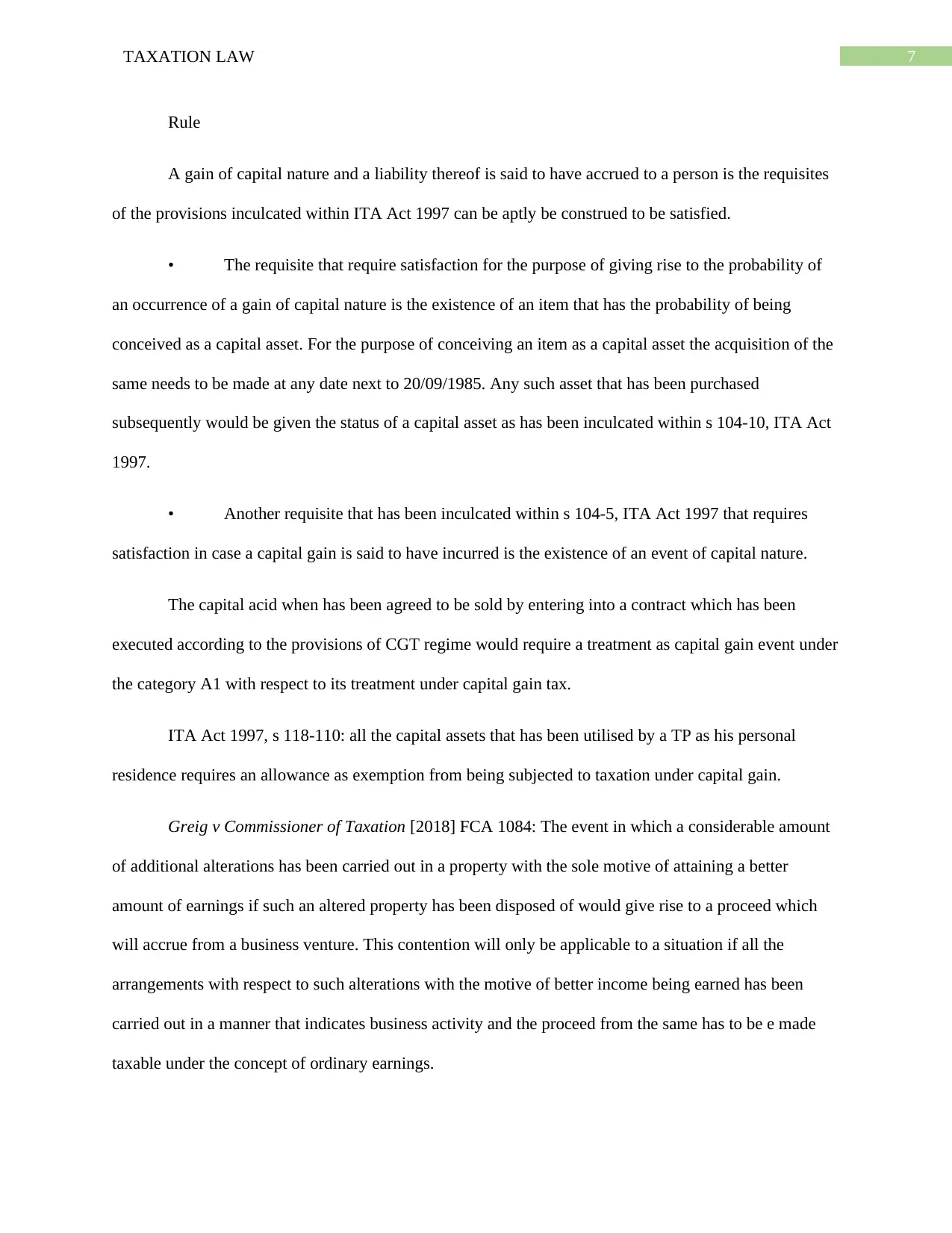
7TAXATION LAW
Rule
A gain of capital nature and a liability thereof is said to have accrued to a person is the requisites
of the provisions inculcated within ITA Act 1997 can be aptly be construed to be satisfied.
• The requisite that require satisfaction for the purpose of giving rise to the probability of
an occurrence of a gain of capital nature is the existence of an item that has the probability of being
conceived as a capital asset. For the purpose of conceiving an item as a capital asset the acquisition of the
same needs to be made at any date next to 20/09/1985. Any such asset that has been purchased
subsequently would be given the status of a capital asset as has been inculcated within s 104-10, ITA Act
1997.
• Another requisite that has been inculcated within s 104-5, ITA Act 1997 that requires
satisfaction in case a capital gain is said to have incurred is the existence of an event of capital nature.
The capital acid when has been agreed to be sold by entering into a contract which has been
executed according to the provisions of CGT regime would require a treatment as capital gain event under
the category A1 with respect to its treatment under capital gain tax.
ITA Act 1997, s 118-110: all the capital assets that has been utilised by a TP as his personal
residence requires an allowance as exemption from being subjected to taxation under capital gain.
Greig v Commissioner of Taxation [2018] FCA 1084: The event in which a considerable amount
of additional alterations has been carried out in a property with the sole motive of attaining a better
amount of earnings if such an altered property has been disposed of would give rise to a proceed which
will accrue from a business venture. This contention will only be applicable to a situation if all the
arrangements with respect to such alterations with the motive of better income being earned has been
carried out in a manner that indicates business activity and the proceed from the same has to be e made
taxable under the concept of ordinary earnings.
Rule
A gain of capital nature and a liability thereof is said to have accrued to a person is the requisites
of the provisions inculcated within ITA Act 1997 can be aptly be construed to be satisfied.
• The requisite that require satisfaction for the purpose of giving rise to the probability of
an occurrence of a gain of capital nature is the existence of an item that has the probability of being
conceived as a capital asset. For the purpose of conceiving an item as a capital asset the acquisition of the
same needs to be made at any date next to 20/09/1985. Any such asset that has been purchased
subsequently would be given the status of a capital asset as has been inculcated within s 104-10, ITA Act
1997.
• Another requisite that has been inculcated within s 104-5, ITA Act 1997 that requires
satisfaction in case a capital gain is said to have incurred is the existence of an event of capital nature.
The capital acid when has been agreed to be sold by entering into a contract which has been
executed according to the provisions of CGT regime would require a treatment as capital gain event under
the category A1 with respect to its treatment under capital gain tax.
ITA Act 1997, s 118-110: all the capital assets that has been utilised by a TP as his personal
residence requires an allowance as exemption from being subjected to taxation under capital gain.
Greig v Commissioner of Taxation [2018] FCA 1084: The event in which a considerable amount
of additional alterations has been carried out in a property with the sole motive of attaining a better
amount of earnings if such an altered property has been disposed of would give rise to a proceed which
will accrue from a business venture. This contention will only be applicable to a situation if all the
arrangements with respect to such alterations with the motive of better income being earned has been
carried out in a manner that indicates business activity and the proceed from the same has to be e made
taxable under the concept of ordinary earnings.
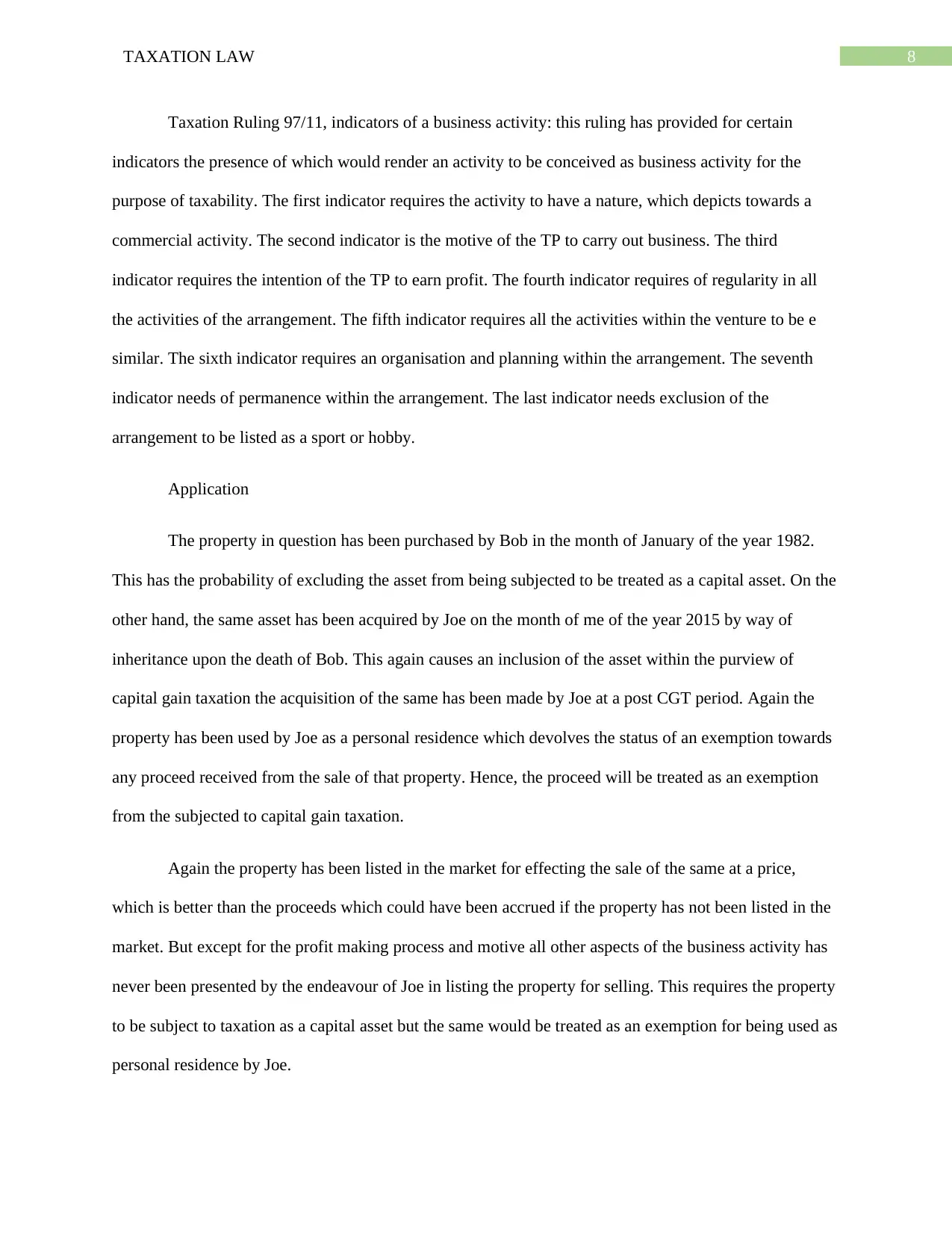
8TAXATION LAW
Taxation Ruling 97/11, indicators of a business activity: this ruling has provided for certain
indicators the presence of which would render an activity to be conceived as business activity for the
purpose of taxability. The first indicator requires the activity to have a nature, which depicts towards a
commercial activity. The second indicator is the motive of the TP to carry out business. The third
indicator requires the intention of the TP to earn profit. The fourth indicator requires of regularity in all
the activities of the arrangement. The fifth indicator requires all the activities within the venture to be e
similar. The sixth indicator requires an organisation and planning within the arrangement. The seventh
indicator needs of permanence within the arrangement. The last indicator needs exclusion of the
arrangement to be listed as a sport or hobby.
Application
The property in question has been purchased by Bob in the month of January of the year 1982.
This has the probability of excluding the asset from being subjected to be treated as a capital asset. On the
other hand, the same asset has been acquired by Joe on the month of me of the year 2015 by way of
inheritance upon the death of Bob. This again causes an inclusion of the asset within the purview of
capital gain taxation the acquisition of the same has been made by Joe at a post CGT period. Again the
property has been used by Joe as a personal residence which devolves the status of an exemption towards
any proceed received from the sale of that property. Hence, the proceed will be treated as an exemption
from the subjected to capital gain taxation.
Again the property has been listed in the market for effecting the sale of the same at a price,
which is better than the proceeds which could have been accrued if the property has not been listed in the
market. But except for the profit making process and motive all other aspects of the business activity has
never been presented by the endeavour of Joe in listing the property for selling. This requires the property
to be subject to taxation as a capital asset but the same would be treated as an exemption for being used as
personal residence by Joe.
Taxation Ruling 97/11, indicators of a business activity: this ruling has provided for certain
indicators the presence of which would render an activity to be conceived as business activity for the
purpose of taxability. The first indicator requires the activity to have a nature, which depicts towards a
commercial activity. The second indicator is the motive of the TP to carry out business. The third
indicator requires the intention of the TP to earn profit. The fourth indicator requires of regularity in all
the activities of the arrangement. The fifth indicator requires all the activities within the venture to be e
similar. The sixth indicator requires an organisation and planning within the arrangement. The seventh
indicator needs of permanence within the arrangement. The last indicator needs exclusion of the
arrangement to be listed as a sport or hobby.
Application
The property in question has been purchased by Bob in the month of January of the year 1982.
This has the probability of excluding the asset from being subjected to be treated as a capital asset. On the
other hand, the same asset has been acquired by Joe on the month of me of the year 2015 by way of
inheritance upon the death of Bob. This again causes an inclusion of the asset within the purview of
capital gain taxation the acquisition of the same has been made by Joe at a post CGT period. Again the
property has been used by Joe as a personal residence which devolves the status of an exemption towards
any proceed received from the sale of that property. Hence, the proceed will be treated as an exemption
from the subjected to capital gain taxation.
Again the property has been listed in the market for effecting the sale of the same at a price,
which is better than the proceeds which could have been accrued if the property has not been listed in the
market. But except for the profit making process and motive all other aspects of the business activity has
never been presented by the endeavour of Joe in listing the property for selling. This requires the property
to be subject to taxation as a capital asset but the same would be treated as an exemption for being used as
personal residence by Joe.
⊘ This is a preview!⊘
Do you want full access?
Subscribe today to unlock all pages.

Trusted by 1+ million students worldwide
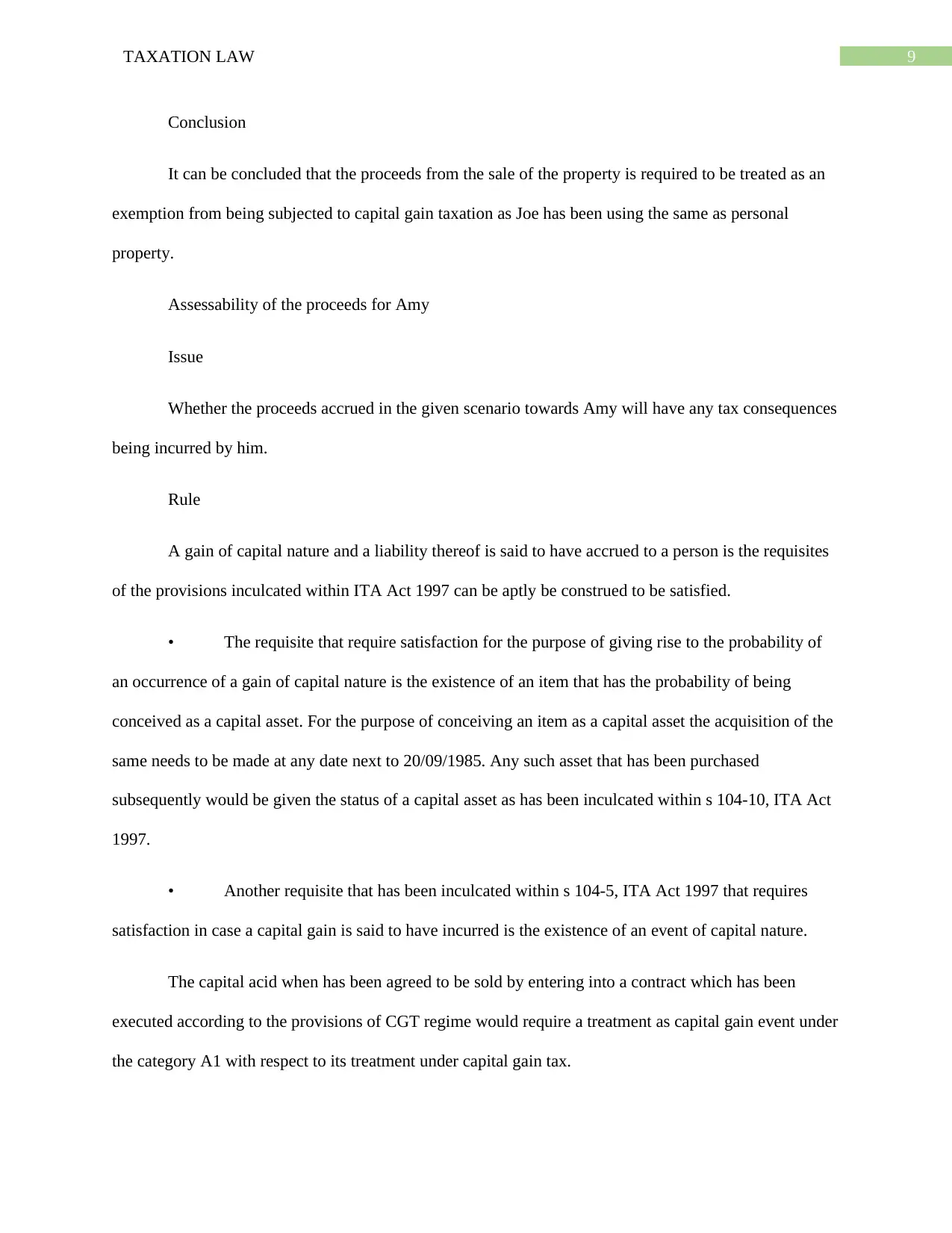
9TAXATION LAW
Conclusion
It can be concluded that the proceeds from the sale of the property is required to be treated as an
exemption from being subjected to capital gain taxation as Joe has been using the same as personal
property.
Assessability of the proceeds for Amy
Issue
Whether the proceeds accrued in the given scenario towards Amy will have any tax consequences
being incurred by him.
Rule
A gain of capital nature and a liability thereof is said to have accrued to a person is the requisites
of the provisions inculcated within ITA Act 1997 can be aptly be construed to be satisfied.
• The requisite that require satisfaction for the purpose of giving rise to the probability of
an occurrence of a gain of capital nature is the existence of an item that has the probability of being
conceived as a capital asset. For the purpose of conceiving an item as a capital asset the acquisition of the
same needs to be made at any date next to 20/09/1985. Any such asset that has been purchased
subsequently would be given the status of a capital asset as has been inculcated within s 104-10, ITA Act
1997.
• Another requisite that has been inculcated within s 104-5, ITA Act 1997 that requires
satisfaction in case a capital gain is said to have incurred is the existence of an event of capital nature.
The capital acid when has been agreed to be sold by entering into a contract which has been
executed according to the provisions of CGT regime would require a treatment as capital gain event under
the category A1 with respect to its treatment under capital gain tax.
Conclusion
It can be concluded that the proceeds from the sale of the property is required to be treated as an
exemption from being subjected to capital gain taxation as Joe has been using the same as personal
property.
Assessability of the proceeds for Amy
Issue
Whether the proceeds accrued in the given scenario towards Amy will have any tax consequences
being incurred by him.
Rule
A gain of capital nature and a liability thereof is said to have accrued to a person is the requisites
of the provisions inculcated within ITA Act 1997 can be aptly be construed to be satisfied.
• The requisite that require satisfaction for the purpose of giving rise to the probability of
an occurrence of a gain of capital nature is the existence of an item that has the probability of being
conceived as a capital asset. For the purpose of conceiving an item as a capital asset the acquisition of the
same needs to be made at any date next to 20/09/1985. Any such asset that has been purchased
subsequently would be given the status of a capital asset as has been inculcated within s 104-10, ITA Act
1997.
• Another requisite that has been inculcated within s 104-5, ITA Act 1997 that requires
satisfaction in case a capital gain is said to have incurred is the existence of an event of capital nature.
The capital acid when has been agreed to be sold by entering into a contract which has been
executed according to the provisions of CGT regime would require a treatment as capital gain event under
the category A1 with respect to its treatment under capital gain tax.
Paraphrase This Document
Need a fresh take? Get an instant paraphrase of this document with our AI Paraphraser
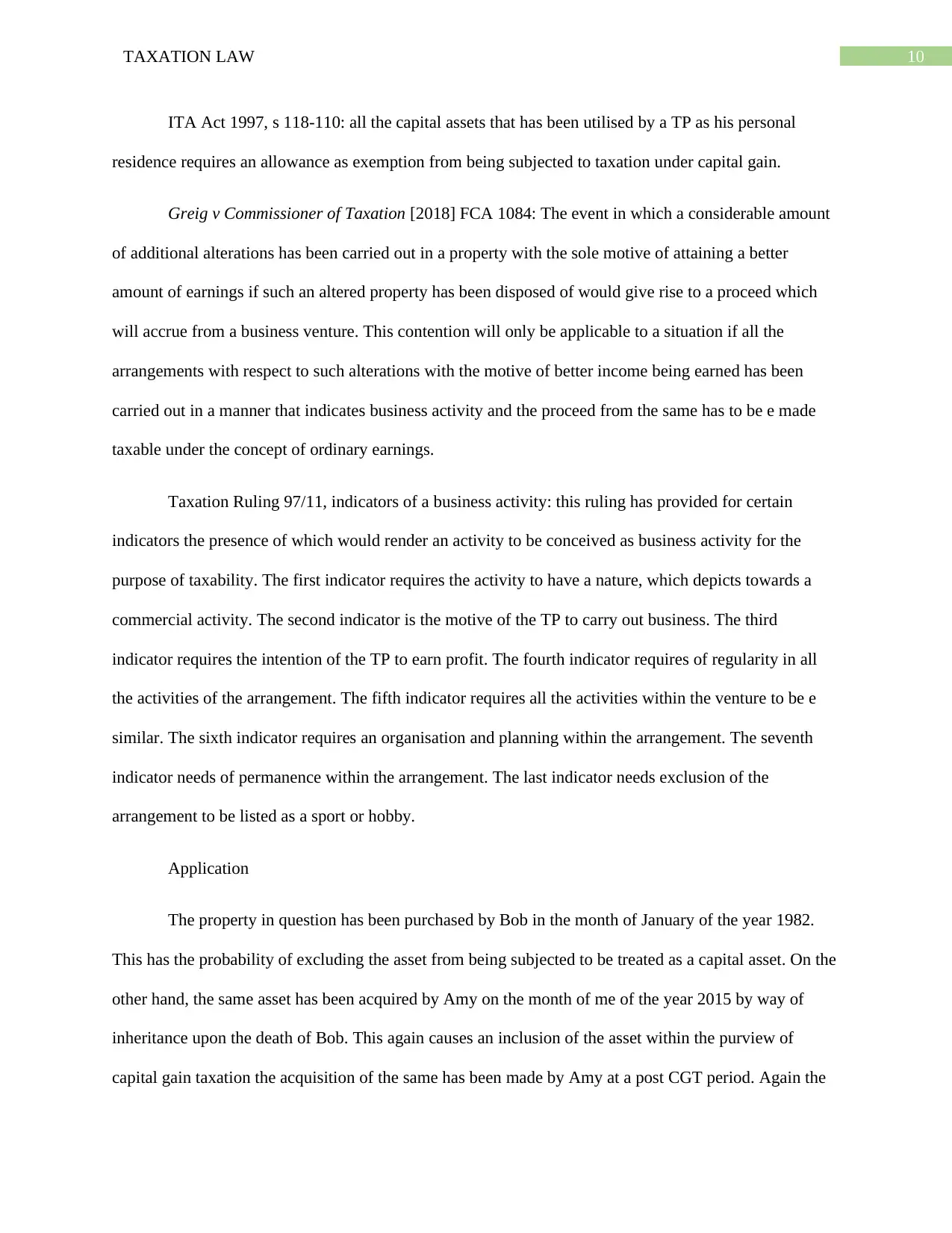
10TAXATION LAW
ITA Act 1997, s 118-110: all the capital assets that has been utilised by a TP as his personal
residence requires an allowance as exemption from being subjected to taxation under capital gain.
Greig v Commissioner of Taxation [2018] FCA 1084: The event in which a considerable amount
of additional alterations has been carried out in a property with the sole motive of attaining a better
amount of earnings if such an altered property has been disposed of would give rise to a proceed which
will accrue from a business venture. This contention will only be applicable to a situation if all the
arrangements with respect to such alterations with the motive of better income being earned has been
carried out in a manner that indicates business activity and the proceed from the same has to be e made
taxable under the concept of ordinary earnings.
Taxation Ruling 97/11, indicators of a business activity: this ruling has provided for certain
indicators the presence of which would render an activity to be conceived as business activity for the
purpose of taxability. The first indicator requires the activity to have a nature, which depicts towards a
commercial activity. The second indicator is the motive of the TP to carry out business. The third
indicator requires the intention of the TP to earn profit. The fourth indicator requires of regularity in all
the activities of the arrangement. The fifth indicator requires all the activities within the venture to be e
similar. The sixth indicator requires an organisation and planning within the arrangement. The seventh
indicator needs of permanence within the arrangement. The last indicator needs exclusion of the
arrangement to be listed as a sport or hobby.
Application
The property in question has been purchased by Bob in the month of January of the year 1982.
This has the probability of excluding the asset from being subjected to be treated as a capital asset. On the
other hand, the same asset has been acquired by Amy on the month of me of the year 2015 by way of
inheritance upon the death of Bob. This again causes an inclusion of the asset within the purview of
capital gain taxation the acquisition of the same has been made by Amy at a post CGT period. Again the
ITA Act 1997, s 118-110: all the capital assets that has been utilised by a TP as his personal
residence requires an allowance as exemption from being subjected to taxation under capital gain.
Greig v Commissioner of Taxation [2018] FCA 1084: The event in which a considerable amount
of additional alterations has been carried out in a property with the sole motive of attaining a better
amount of earnings if such an altered property has been disposed of would give rise to a proceed which
will accrue from a business venture. This contention will only be applicable to a situation if all the
arrangements with respect to such alterations with the motive of better income being earned has been
carried out in a manner that indicates business activity and the proceed from the same has to be e made
taxable under the concept of ordinary earnings.
Taxation Ruling 97/11, indicators of a business activity: this ruling has provided for certain
indicators the presence of which would render an activity to be conceived as business activity for the
purpose of taxability. The first indicator requires the activity to have a nature, which depicts towards a
commercial activity. The second indicator is the motive of the TP to carry out business. The third
indicator requires the intention of the TP to earn profit. The fourth indicator requires of regularity in all
the activities of the arrangement. The fifth indicator requires all the activities within the venture to be e
similar. The sixth indicator requires an organisation and planning within the arrangement. The seventh
indicator needs of permanence within the arrangement. The last indicator needs exclusion of the
arrangement to be listed as a sport or hobby.
Application
The property in question has been purchased by Bob in the month of January of the year 1982.
This has the probability of excluding the asset from being subjected to be treated as a capital asset. On the
other hand, the same asset has been acquired by Amy on the month of me of the year 2015 by way of
inheritance upon the death of Bob. This again causes an inclusion of the asset within the purview of
capital gain taxation the acquisition of the same has been made by Amy at a post CGT period. Again the
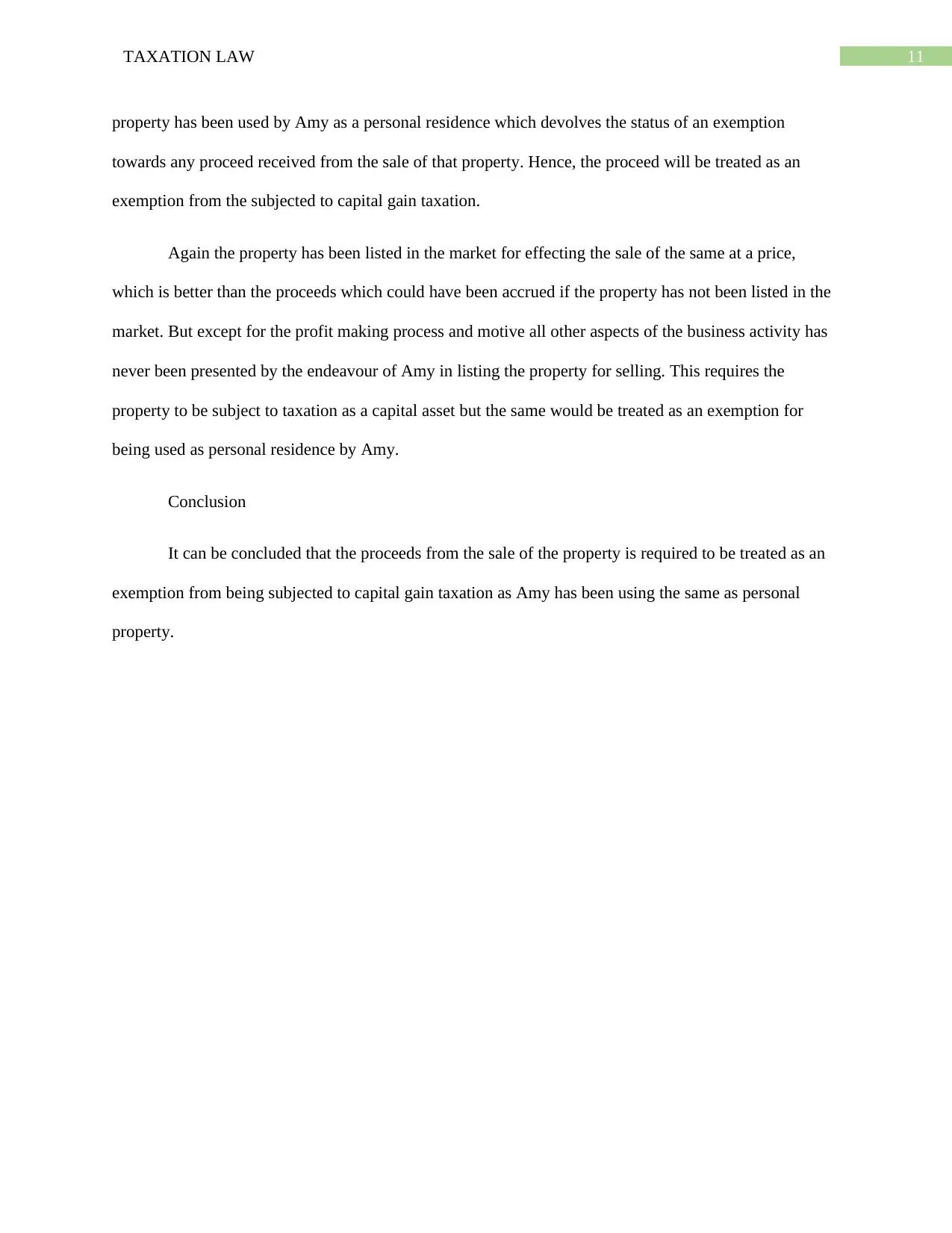
11TAXATION LAW
property has been used by Amy as a personal residence which devolves the status of an exemption
towards any proceed received from the sale of that property. Hence, the proceed will be treated as an
exemption from the subjected to capital gain taxation.
Again the property has been listed in the market for effecting the sale of the same at a price,
which is better than the proceeds which could have been accrued if the property has not been listed in the
market. But except for the profit making process and motive all other aspects of the business activity has
never been presented by the endeavour of Amy in listing the property for selling. This requires the
property to be subject to taxation as a capital asset but the same would be treated as an exemption for
being used as personal residence by Amy.
Conclusion
It can be concluded that the proceeds from the sale of the property is required to be treated as an
exemption from being subjected to capital gain taxation as Amy has been using the same as personal
property.
property has been used by Amy as a personal residence which devolves the status of an exemption
towards any proceed received from the sale of that property. Hence, the proceed will be treated as an
exemption from the subjected to capital gain taxation.
Again the property has been listed in the market for effecting the sale of the same at a price,
which is better than the proceeds which could have been accrued if the property has not been listed in the
market. But except for the profit making process and motive all other aspects of the business activity has
never been presented by the endeavour of Amy in listing the property for selling. This requires the
property to be subject to taxation as a capital asset but the same would be treated as an exemption for
being used as personal residence by Amy.
Conclusion
It can be concluded that the proceeds from the sale of the property is required to be treated as an
exemption from being subjected to capital gain taxation as Amy has been using the same as personal
property.
⊘ This is a preview!⊘
Do you want full access?
Subscribe today to unlock all pages.

Trusted by 1+ million students worldwide
1 out of 13
Related Documents
Your All-in-One AI-Powered Toolkit for Academic Success.
+13062052269
info@desklib.com
Available 24*7 on WhatsApp / Email
![[object Object]](/_next/static/media/star-bottom.7253800d.svg)
Unlock your academic potential
Copyright © 2020–2025 A2Z Services. All Rights Reserved. Developed and managed by ZUCOL.




